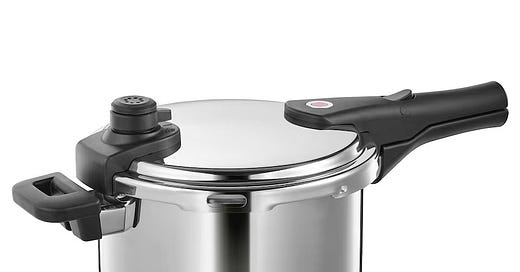Do you own a pressure cooker, either a traditional style manual version, or a modern electric ‘Instant Pot’ version? If you don’t, let me say two very sexy words right now: energy efficiency. That got your attention?
I must admit that I do get a little buzz of excitement when a risk-happy Masterchef contestant says they are going to use a pressure cooker. Why? Because, once sealed, the pressure cooker turns into Schrödinger’s Box. We’re all on tenterhooks until the chef carefully opens the cooker. Will the beef cheeks be revealed as meltingly tender, maybe disastrously welded to the bottom of the pot or disappointingly just not cooked enough. It adds a nice little element of Russian roulette to the show. After all, there’s no fun in betting if the ice-cream will be frozen in time. Spoiler, we all know it won’t.
The pressure cooker is where two key parts of my life intersect: physics and food. At a basic level, it’s the Ideal Gas Law in action. Simply put, in a closed system, pressure and temperature are linearly related. If the pressure increases, the temperature increases and vice versa. As the temperature rises in a pressure cooker, the trapped steam causes the internal pressure to rise, thus raising the temperature past the regular boiling point. A domestic pressure cooker achieves temperatures up to roughly 120 °C and hence much faster cooking times. This means that they’re also a good energy efficient cooking option. But possibly a bit more terrifying to some than an air-fryer.
As a child, my mother’s pressure cooker terrified me. (To be brutally honest, it still does.) Sitting atop the Stanley range, it would hiss and bubble, with the jiggler weight occasionally blasting loose a gust of steam when things got too hot. You could feel its malevolence. Over the years, it got gradually more battered, and eventually the jiggler was lost. You’d think that getting a proper replacement for this safety regulator would be sensible, but with an uncharacteristic disregard for health and safety, my mother replaced the jiggler with a piece of cork. Bizarrely, this seemed to work just fine; the house remains standing after all, but I still keep a healthy distance.
I like to think my mother would have gotten on well with Denis Papin, the 17th century inventor of the pressure cooker. After all, they both seem to like taking risks. His original ‘Digester’ had significant safety issues, with an unfortunate tendency to explode. Talk about ruining dinner. Thankfully the addition of vent valves and safety locks, features which persist today, finally made the pressure cooker a useful tool for cooks everywhere from the 1970s onwards, and gave the MasterChef contestant a weapon of choice.
More importantly, it gave Corkonians the perfect way to cook spiced beef. I’ve often heard people lamenting that their spiced beef turned out dry and tough when cooked. It’s no problem when you have a pressure cooker, though the same method will also work fine for a normal pot, it just takes longer. Simply put the spiced beef joint into the pot with plenty of liquid, some brown sugar, a bay leaf and a glass of white wine, and fire her up. After about 60-90 mins, depending, release the pressure, open when safe and let the spiced beef partially cool in the cooking liquid. Remove and slice as required.
If you want to read more about the history of the pressure cooker, visit British Food History.





